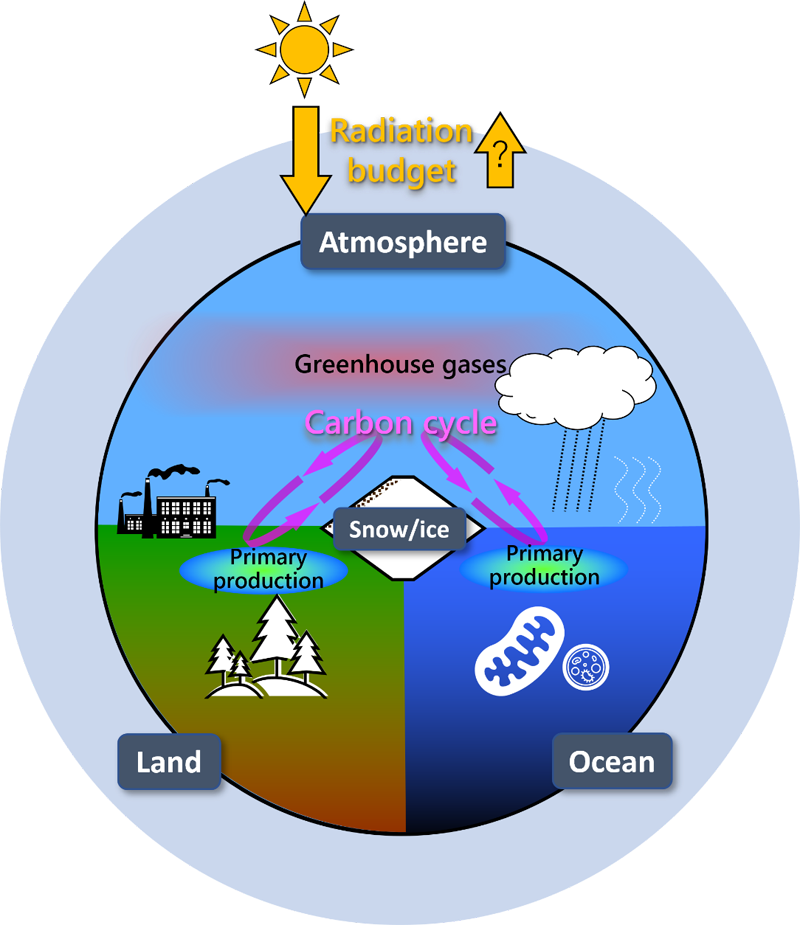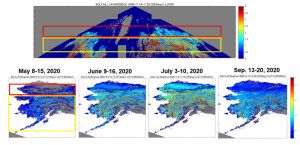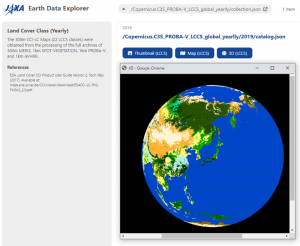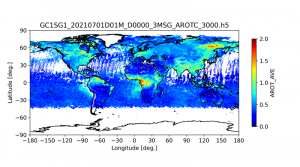

Research and Development
2022.06.06 Mon
“SHIKISAI” (GCOM-C) marks the fifth year since its successful launch
About Global Change Observation Mission – Climate “SHIKISAI” (GCOM-C)
The Global Change Observation Mission – Climate “SHIKISAI” (GCOM-C) was launched from JAXA Tanegashima Space Center on December 23, 2017. Together with the Global Change Observation Mission – Water “SHIZUKU” (GCOM-W), GCOM-C is currently operated as a part of the mission for the purpose of comprehensive and long-term observation of global environmental changes. While GCOM-W plays a role mainly for observing water cycle, GCOM-C observes various physical quantities on the Earth related to the global radiation and heat budget*1 and carbon cycle (mainly primary production*2) (Figure 1). For example, the observation target of GCOM-C includes the product related to the atmospheric environment such as clouds and aerosols*3, the terrestrial environment such as vegetation index and land surface temperature, the marine environment such as sea surface temperature and chlorophyll-a concentration*4, and the snow and ice environment such as snow cover area and sea ice distribution. Since these physical quantities are changing closely affecting each other, it is extremely important to accumulate satellite data comprehensively for a long term.
The Second generation GLobal Imager (SGLI) onboard GCOM-C is sensitive to near-ultraviolet to thermal infrared region (wavelengths from 0.38μm to 12μm) where energy reflected and emitted from the Earth is particularly high. SGLI can obtain various information about the Earth, including light which is invisible to the human eye. By observing with wide angle (swath: more than 1150 km) from space, SGLI can monitor global change at a high frequency (about once every two days at mid-latitudes), which cannot be covered by ground-based observations alone.
Currently, observation data from GCOM-C is contributing not only for the monitoring of ongoing global environmental changes, but also for research to improve the accuracy of future predictions with numerical models. The data use is also expanding to the fields such as assessment of fishing grounds and growing environments based on sea surface temperature, phytoplankton, etc., evaluation of agricultural production over wide areas based on solar radiation and vegetation index, and even disaster response, including volcano monitoring.

*1 radiation and heat budget: Balance between solar radiation energy entering the Earth and leaving energy from the Earth. Radiative equilibrium is a condition where the incoming energy and the outgoing energy are in balance.
*2 primary production: Creation of organic matter from inorganic matter like carbon dioxide by organisms such as plants on land and phytoplankton in the sea.
*3 aerosol: A tiny liquid suspended in a gas or a mixture of solid particles and surrounding gas. Particle sizes range from 0.001μm to about 100μm. Yellow dust and PM2.5 are also included in aerosol.
*4 chlorophyll-a concentration: Concentration of the major photosynthetic pigments within phytoplankton in the marine surface layer.
4-part article series of GCOM-C
Here in “Updates on Earth”, we will introduce the achievements and future prospects of GCOM-C, which is now in its fifth year since the launch, in four topics: (1) atmosphere, (2) land, (3) ocean, and (4) snow and ice.
■Links for each article
(1) Atmosphere
(2) Land
(3) Ocean (to be prepared)
(4) Snow and Ice (to be prepared)
Related Website for GCOM-C
GCOM-C data is distributed for free of charge and anyone can use it (Site Policy, Terms of Use). Followings are websites for persons interested in using GCOM-C.
EORC/GCOM-C Website
The site provides detailed information (algorithms, verification and calibration status, etc.) about GCOM-C.
JASMES Portal
The site provides the information on the current status and seasonal/interannual variability of climate forming physical quantities, including GCOM-C data.
JASMES/SGLI Standard data Monitor
The site provides images (Japan area and global) of GCOM-C/SGLI standard products.
JASMES/SGLI Near-Realtime Monitor
The site provides images (Japan area) of GCOM-C/SGLI near real-time products. Different from standard products, near real-time product is for alliance organizations created with delivery time as the highest priority.
Globe Portal System, G-Portal
G-Portal is a portal system allowing users to search (by satellites and sensors/by physical quantity), and download products acquired by JAXA’s Earth observation satellite. File formats are GeoTIFF, HDF, NetCDF, etc.
JAXA for Earth on COVID-19
JAXA’s earth observation satellites are monitoring the earth’s surface to detect the changes in the global environment and human society related to COVID-19. The site provides analysis results on the field of transportation, logistics, industry, greenhouse gas and water quality.
Earth Observing Dashboard
In cooperation with JAXA, NASA and ESA, the site offers analysis results of the satellite data regarding the changes in global environment and socio-economic activities. The dashboard provides objective perspectives and information for a broader understanding of environmental change, climate change, and the social and economic impacts caused by these changes for all kinds of public, including people not familiar with satellites.
Search by Year
Search by Categories
Tags
-
#Precipitation
-
#GHG
-
#GPM
-
#GOSAT
-
#Simulation
-
#GCOM-W
-
#Drought
-
#Fire
-
#Forest
-
#Cooperation
-
#Himawari
-
#Typhoon
-
#DPR
-
#NEXRA
-
#ALOS
-
#GSMaP
-
#Climate change
-
#carbon-cycle
-
#API
-
#Today's Earth
-
#Land
-
#Satellite Data
-
#Aerosol
-
#Public Health
-
#GCOM-C
-
#Sea
-
#Atmosphere
-
#Ice
-
#Flood
-
#Water Cycle
-
#AW3D
-
#G-Portal
-
#EarthCARE
-
#Volcano
-
#Agriculture
Related Resources
Research and Development Related Articles
-
 Research and Development 2022.06.14 Tue “SHIKISAI” (GCOM-C) marks the fifth year since its successful launch: Achievements in the terrestrial environment
Research and Development 2022.06.14 Tue “SHIKISAI” (GCOM-C) marks the fifth year since its successful launch: Achievements in the terrestrial environment -
 Research and Development 2022.06.09 Thu A prototype version of the data provision service “JAXA Earth API” is now available!
Research and Development 2022.06.09 Thu A prototype version of the data provision service “JAXA Earth API” is now available! -
 Research and Development 2022.06.06 Mon “SHIKISAI” (GCOM-C) marks the fifth year since its successful launch: Achievements on atmospheric environment
Research and Development 2022.06.06 Mon “SHIKISAI” (GCOM-C) marks the fifth year since its successful launch: Achievements on atmospheric environment -
 Research and Development 2021.12.22 Wed Performance improvement in global precipitation data from satellites
Research and Development 2021.12.22 Wed Performance improvement in global precipitation data from satellites

















